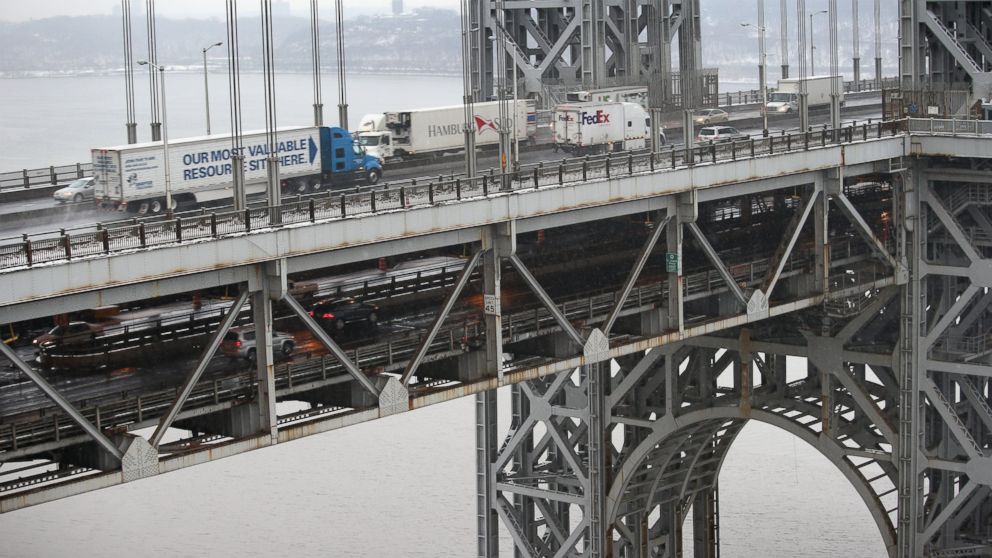George Washington Bridge Suicide Jumper Highlights Lack of Barriers
NY-NJ Port Authority Police Grab Woman Dangling Over Water

March 5, 2014— -- A 25-year-old woman dangling over the edge of the upper level of New York’s George Washington Bridge was stopped from jumping to her death by a cop, according to the Port Authority of New York and New Jersey.
Officer Christopher Outhouse climbed over an inner railing yesterday morning and grabbed the woman whose torso was hanging 212-feet over the icy Hudson River. Authorities did not release her name, but said she was taken to the hospital. She had threatened to kill herself in text messages and authorities found several unfilled prescriptions for medication to treat bipolar disorder and depression.
Hers was the fourth suicide attempt in the first two months of this year, according to Port Authority spokesman Joe Pentangelo. One, a 19-year-old male on Feb. 22, was successful. In 2013, he confirmed 15 suicides and 49 interventions.
Suicide numbers are greater at the 81-year-old bridge than all other local bridges combined, but Pentangelo would not comment on what prevention measures had been taken.
Civilian security guards assist Port Authority Police in watching for jumpers, but pedestrian walkways and low railings make the bridge easily accessible.
Since 2000, suicides off the bridge have averaged about six a year, but are on the rise, according to USA Today; 10 deaths were reported in 2010, but by 2012, there were 18 successful jumps.
'Suicide Bridge' reduces impulse to jump.
In 2010, two made national headlines: 18-year-old Rutgers student Tyler Clementi, who jumped from the bridge after he was secretly filmed having an intimate encounter with a man, and chef Joseph Cerniglia, a contestant on the reality cooking show "Kitchen Nightmares," who had mounting restaurant debts.
In February 2013, 22-year-old Ashley Riggitano, a recent grad of the Laboratory Institute of Merchandising in Manhattan, jumped off the bridge. And in October, Donovan Dickson a 24-year-old teacher from New Jersey’s Peddie School, leapt to his death, landing on a patch of gravel.
The National Suicide Prevention Lifeline promotes the use of bridge barriers as the "most effective" means of bridge suicide prevention. They also recognize that signage or other public education media near bridges promoting awareness of hotlines can supplement such barriers.
In 2012, Port Authority police ordered foot and car patrols be intensified with patrols that looked out for jumpers. That year, 43 attempted suicide and 18 were successful, according to the Port Authority.
But despite its reputation as a suicide mecca, the George Washington Bridge still has no barriers or nets to dissuade suicide attempts.
About a dozen telephones along its walkways are labeled in Spanish and English, “Need Help,” which can connect potential jumpers to suicide hotlines.
Trust pulled woman back from the brink of suicide.
Some studies show that iconic bridges and other physical structures draw those with suicidal impulses, but if barriers are in place, many deaths can be prevented.
The biggest “suicide magnet” in the world is San Francisco’s Golden Gate Bridge, with nearly 2,000 so far, according to the Los Angeles Times. In 2013, there were 10 confirmed deaths in August alone, the most suicides in any month in the bridge’s history.
Besides its historic appeal for jumpers, the bridge offers easy access with parking lots on either side and walkways for pedestrians and bikers. Some critics say its low rail – only four-feet high – is no deterrent. The newspaper reports that “anyone can climb over it.”
In 2008, the city proposed a suicide prevention net, but it was never funded. “As a result, the Golden Gate Bridge continues to be the only major international suicide landmark without a barrier.”




